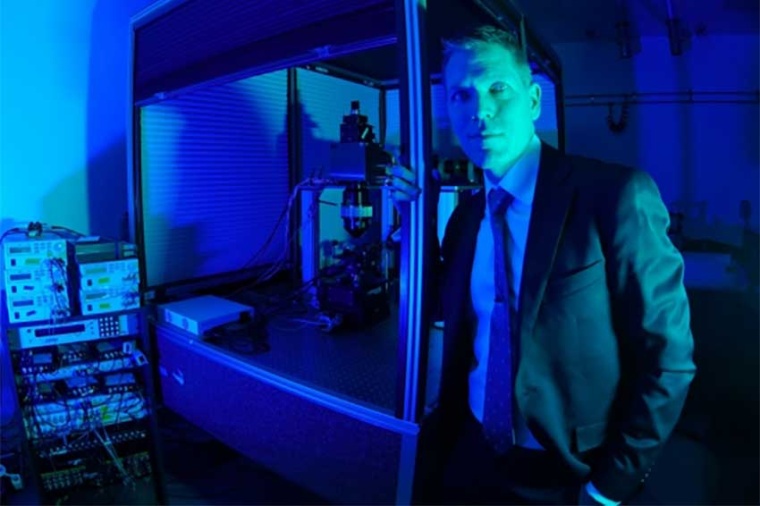A two-photon microscope looks into the brain
With their new instrument, University of California researchers achieve a large field of view up to 25 square millimeters to provide subcellular resolution of multiple areas of the brain.
Advancing our understanding of the human brain will require new insights into how neural circuitry works in mammals. These investigations require monitoring brain activity with a microscope that provides resolution high enough to see individual neurons and their neighbors. Two-photon fluorescence microscopy has significantly enhanced researchers’ ability to do just that, and the lab of Spencer LaVere Smith at UC Santa Barbara is working to push the frontiers of multi-photon microscopy for neuroscience research. Now, the researchers report the development of a new microscope they describe as “Dual Independent Enhanced Scan Engines for Large Field-of-view Two-Photon imaging (Diesel2p).” Their two-photon microscope provides unprecedented brain-imaging ability. The device has the largest field of view up to 25 square millimeters of any such instrument, allowing it to provide subcellular resolution of multiple areas of the brain.

“We’re optimizing for three things: resolution to see individual neurons, a field of view to capture multiple brain regions simultaneously, and imaging speed to capture changes in neuron activity during behavior,” Smith explained. “The events that we’re interested in imaging last less than a second, so we don’t have time to move the microscope; we have to get everything in one shot, while still making sure that the optics can focus ultrafast pulses of laser light.” The lasers that drive two-photon imaging systems, deliver ultrafast, ultra-intense pulses of light. A single beam, with 80 million pulses per second, is split into two wholly independent scan engine arms, enabling the microscope to scan two regions simultaneously, with each configured to different imaging parameters.
In previous iterations of the instrument, the two lasers were yoked and configured to the same parameters, an arrangement that strongly constrains sampling. Optimal scan parameters, such as frame rate and scan region size, vary across distributed neural circuitry and experimental requirements, and the new instrument allows for different scan parameters to be used for both beams. The device, which incorporates several custom-designed and custom-manufactured elements, including the optical relays, the scan lens, the tube lens and the objective lens, is already being broadly adopted for its ability to provide high-speed imaging of neural activity in widely scattered brain regions.
Smith is committed to ensuring open access to the instrument. He and his colleagues released a preprint that included the engineering details needed to replicate it. They also shared the technology with colleagues at Boston University, where researchers in Jerry Chen’s lab have already made modifications to suit their own experiments. “This is exciting,” Smith said. “They didn’t have to start from scratch like we did. They could build off of our work. Two companies, INSS and CoSys, have sold systems based on our designs. Since there is no patent, and won’t be, this technology is free for all to use and modify however they see fit.”
Two-photon microscopy is a specialized type of fluorescent microscopy. To perform such work, researchers genetically engineer mice so that their neurons contain a fluorescent indicator of neuron activity. The indicator was made by combining a fluorescent protein from jellyfish and a calcium-binding protein that exists in nature. The approach leverages the brief, orders-of-magnitude increase in calcium that a neuron experiences when firing. When the laser is pointed at the neuron, and the neuron is firing, calcium comes in, the protein finds the calcium and, ultimately, fluoresces. Two-photon imaging enhances fluorescence microscopy by employing the quantum behavior of photons in a way that prevents a considerable amount of out-of-focus fluorescence light from being generated.
The light in a two-photon microscope behaves differently, creating a single point of light that is in sharp focus, eliminating all out-of-focus light from reaching the imaging lens. “The image reveals only light from that plane we’re looking at, without much background signal from above or below the plane,” Smith explained. “The brain has optical properties and a texture like butter; it’s full of lipids and aqueous solutions that make it hard to see through. With normal optical imaging, you can see only the very top of the brain. Two-photon imaging allows us to image deeper down and still attain sub-cellular resolution.”
Another advantage of two-photon excitation light is that it uses lower-energy, longer-wavelength light in the near-infrared range. Such light scatters less when passing through tissue, so it can be sharply focused deeper into tissue. Moreover, the lower-energy light is less damaging to the sample than shorter wavelengths, such as ultraviolet light. Smith’s lab tested the device in experiments on mice, observing their brains while they performed tasks such as watching videos or navigating virtual reality environments. Each mouse has received a glass implant in its skull, providing a literal window for the microscope into its brain.
“I’m motivated by trying to understand the computational principles in neural circuitry that let us do interesting things that we can’t currently replicate in machines,” he said. “There are interesting computational principles that we cannot yet replicate in human-made machines that exist in the brains of mice,” Smith continued, “and I want to start to uncover that. It’s why I wanted to build this microscope.” (Source: UCSB)











